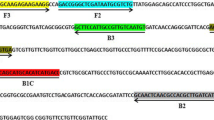Abstract
Studies were performed to evaluate the applicability and validation of the PCR test according to Inoue and Takikawa (2021) in the diagnosis of Pseudomonas syringae pv. maculicola (McCulloch) Young et al. (Psm). The test was optimized for real-time application. For this purpose, the SYBR Green I intercalating dye with a fluorescence emission wavelength of 520 nm was added to the reaction mixture. Method performance criteria were determined according to EPPO standard PM 7/098 (4). Evaluation the applicability of the test in real-time mode showed sufficient analytical sensitivity, which was 103–104 CFU/mL, which corresponded to a low and medium degree of infection. Determination of analytical specificity showed false positive results with P. syringae pv. tomato. There is also in silico data on a 100% match with P. syringae pv. avii, pv. persicae, and pv. spinaciae. These pathovars affect other crop species; there is also no information on their distribution in Russia; therefore, they were not considered in these studies. Determining selectivity showed the effect of the matrix on the sensitivity of the test. Thus, the detection threshold decreased from 103 to 104 CFU/mL when studying extracts of vegetative parts of rapeseed as compared to seeds. The repeatability and reproducibility of the test was 100% when the concentration of the target object in the matrix was 104 CFU/mL. The obtained values of the test efficiency criteria indicate the possibility of using PCR according to Inoue and Takikawa (2021) for direct diagnosis of the phytopathogen from the plant extract of seeds and vegetative parts of Psm host plants. The method was tested on rapeseed samples from Tula and Lipetsk oblasts and Zabaykalsky krai. Psm genetic material was found in one rape sample from Tula oblast.




Similar content being viewed by others
REFERENCES
Xin, X.F., Kvitko, B., and He, S.Y., Pseudomonas syringae: what it takes to be a pathogen, Nat. Revol.Microbiol., 2018, vol. 16, no. 5, pp. 316–328.
Alvarez-Mejia, C., Hernández-Guzmán, G., López-Ramírez, V., et al., Genetic Diversity in Pseudomonas syringae pv. maculicola strains, J. Pure Appl. Microbiol., 2018, vol. 3, no. 12, pp. 1233–1238.
Gironde, S. and Manceau, C., Housekeeping 3 gene sequencing and multilocus variable-number tandem-repeat analysis to identify subpopulations within Pseudomonas syringae pv. maculicola and Pseudomonas syringae pv. tomato that correlate with host specificity, Appl. Environ. Microbiol., 2012, vol. 78, no. 9, pp. 3266–3279.
Fujikawa, T., Takikawa, Y., and Inoue, Y., Complete and draft genome sequences of the cruciferous pathogens Pseudomonas cannabina pv. alisalensis and Pseudomonas syringae pv. maculicola, Microbiol. Resour. Announce., 2021, vol. 10, no. 17. https://www. ncbi.nlm.nih.gov/pmc/articles/PMC8086205/. Cited October 18, 2021. https://doi.org/10.1128/MRA.00149-21
Fatmi, M., Walcott, R.R., Schaad, N.W., et al., Detection of Plant-Pathogenic Bacteria in Seed, St. Paul: APS-Press, 2017.
Malakhov, A.V. and Khorunzhin, M.G., Economic prerequisites for rapeseed production in Russia and the Altai Territory, Materialy XIII Mezhdunarodnoi nauchno-prakticheskoi konferentsii “Agrarnaya Nauka-sel’skomu khozyaistvu” (Proc. XIII Int. Sci.-Pract. Conf. “Agricultural Science in Agriculture”) Barnaul: Altai. Gos. Agrar. Univ., 2018, no. 2, pp. 165–167.
Oleinikova, E.N., Yanova, M.A., Pyzhikova, N.I., et al., Spring raps – perspective culture for the development of agrarian and industrial complex of Krasnoyarsk region, Vestn. Krasnoyarsk. Gos. Agrar. Univ., 2019, vol. 1, no. 142, pp. 74–80.
Prikhod'ko, S.I., Yaremko, A.B., and Kornev, K.P., Characterization and spread of bacterial leaf spot of cabbage Pseudomonas syringae pv. maculicola (McCulloch) Young et al., Fitosanitariya Karant. Rast., 2020, no. 3, pp. 24–32.
Iličić, R., Balaž, J., Stojšin, V., Bagi, F., Pivić, R., Stanojković-Sebić, A., and Jošić, D., Molecular characterization of Pseudomonas syringae pvs. from different host plants by repetitive sequence-based PCR and multiplex-PCR, Zemdirbyste-Agriculture, 2016, vol. 103, no. 2, pp. 199–206.
Takikawa, Y. and Takahashi, F., Bacterial leaf spot and blight of crucifer plants (Brassicaceae) caused by Pseudomonas syringae pv. maculicola and P. cannabina pv. alisalensis, J. Gen. Plant Pathol., 2014, vol. 80, pp. 466–474.
Inoue, Y. and Takikawa, Y., Primers for specific detection and identification of Pseudomonas syringae pv. maculicola and P. cannabina pv. alisalensis, Appl. Microbiol. Biotechnol., 2021. vol. 105, no. 4, pp. 1575–1584.
Hougs, L., Gatto, F., Goerlich, O., et al., Verification of analytical methods for GMO testing when implementing interlaboratory validated methods, Testing and Analysis of GMO-Containing Foods and Feed, Boca Raton: CRC Press, 2019, pp. 245–266.
Bikbulatova, S.M., Chemeris, D.A., Nikonorov, Yu.M., et al., Methods for detecting polymerase chain reaction in real time, Vestn. Bashk. Univ., 2012, vol. 17, no. 1, pp. 59–67.
Takikawa, Y., Synonymy of Pseudomonas syringae pv. maculicola and Pseudomonas syringae pv. tomato, Proc. 8th Int. Conf. Plant Pathog. Bact., Versailles: INRA, 1994, pp. 199–204.
Author information
Authors and Affiliations
Corresponding author
Additional information
Translated by A. Bulaev
About this article
Cite this article
Prikhodko, S.I., Yaremko, A.B. & Kornev, K.P. Applying Molecular Methods in Diagnosing the Pathogen of Bacterial Leaf Spot in Cauliflower Pseudomonas syringae pv. maculicola (McCulloch) Young et al.. Russ. Agricult. Sci. 48, 180–186 (2022). https://doi.org/10.3103/S1068367422030107
Received:
Revised:
Accepted:
Published:
Issue Date:
DOI: https://doi.org/10.3103/S1068367422030107




